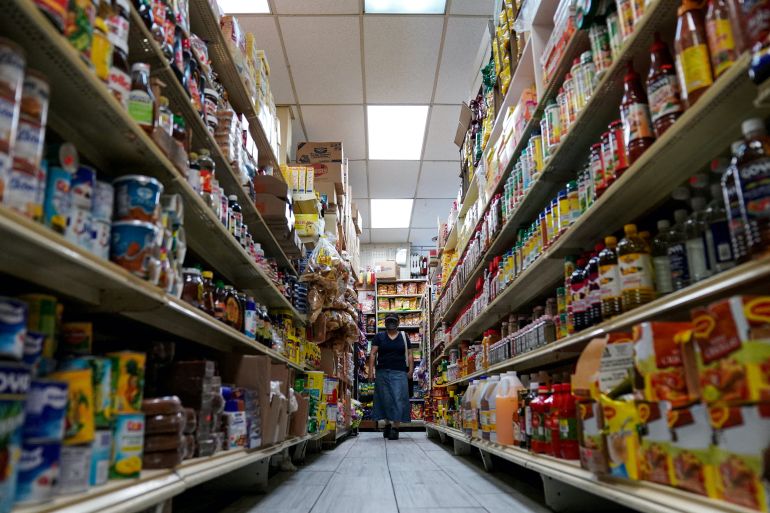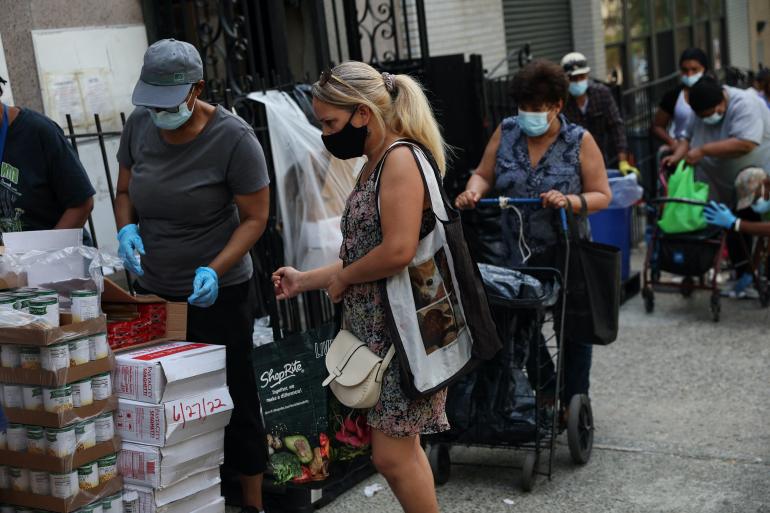US inflation slows for 2nd month but remains stubbornly high
Americans continue to struggle to make ends meet as the cost of living surges.

Inflation in the United States has slowed for a second straight month on a sharp fall in petrol prices, yet excluding energy most other items got more expensive in August, a sign that inflation remains a heavy burden for American households.
Consumer prices surged 8.3 percent in August compared with a year earlier, the government said on Tuesday, down from an 8.5 percent jump in July and a four-decade high of 9.1 percent in June. On a monthly basis, prices rose 0.1 percent, after a flat reading in July.
Keep reading
list of 4 itemsUS consumer spending rises in June as inflation takes bigger bite
‘Uncharted territory’: Five key takeaways on US inflation
Five things to know about the next US housing crisis
But excluding the volatile food and energy categories, so-called “core prices” jumped 0.6 percent from July to August — up sharply from 0.3 percent the previous month and dashing hopes, for now, that core prices might be starting to moderate. In the 12 months ending in August, core prices jumped 6.3 percent, up from 5.9 percent in July. Rents, medical care services and new cars all grew more expensive in August.
Core prices typically provide a clearer read on where costs are headed than overall inflation does. Stock index futures tumbled on the worse-than-expected core figures, with many investors fearful that the Federal Reserve will now raise interest rates even faster in its drive to curb inflation.
Wall Street on Tuesday had its worst day in over two years as the inflation numbers dashed investors’ hope that the Fed would ease on rate hikes.
All three major US stock indexes closed sharply lower, snapping four-day winning streaks and notching their biggest one-day percentage drops since June 2020 during the throes of the COVID-19 pandemic.
The Dow Jones Industrial Average fell 1,276.37 points, or 3.94 percent, to end the session at 31,104.97, the S&P 500 lost 177.72 points, or 4.32 percent, to 3,932.69 and the Nasdaq Composite dropped 632.84 points, or 5.16 percent, to 11,633.57.
Inflation remains far higher than many Americans have ever experienced and is keeping pressure on the Fed. The central bank is expected to announce another big increase in its benchmark interest rate next week, which will lead to higher costs for many consumer and business loans.
Inflation has escalated families’ grocery bills, rents and utility costs, among other expenses, inflicting hardships on many households and deepening gloom about the economy despite strong job growth and low unemployment. Groceries continue to rise rapidly, jumping 0.7 percent from July to August. In the past year, they have soared 13.5 percent — the biggest 12-month increase since 1979.
With the Inflation Reduction Act, the American people won and the special interests lost.
Today, we celebrate its passage at the White House. pic.twitter.com/FQDRLkKK1m
— President Biden (@POTUS) September 13, 2022
“Overall, prices have been essentially flat in our country these last two months: that is welcome news for American families, with more work still to do. Gas prices are down an average of $1.30 a gallon since the beginning of the summer,” US President Joe Biden said in a White House statement on Tuesday morning.
Biden also reiterated his endorsement of his Inflation Reduction Plan, emphasising that “my economic plan is showing that, as we bring prices down, we are creating good paying jobs and bringing manufacturing back to America”.
Has inflation peaked?
Even if inflation peaks, economists expect it could take two years or more to fall back to something close to the Fed’s annual 2 percent target. The cost of rental apartments and other services, such as healthcare, are likely to keep rising in the months ahead.
Republicans have sought to make inflation a central issue in the midterm congressional elections. They blame President Biden’s $1.9 trillion stimulus package passed last year for much of the increase. Many economists generally agree, though they also say that snarled supply chains, Russia’s invasion of Ukraine and widespread shortages of items like semiconductors have been key factors in the inflation surge.

Yet the signs that inflation might have peaked — or will soon — could bolster Democrats’ prospects in the midterm elections and may already have contributed to slightly higher public approval ratings for Biden.
In his speeches, Biden has generally stopped referring to the effect of high prices on family budgets. He has instead highlighted his administration’s recent legislative accomplishments, including a law enacted last month that’s intended to reduce pharmaceutical prices and fight climate change.
Nationally, the average cost of a gallon of petrol has dropped to $3.71 (about $0.98 per litre), down from just above $5 (about $1.32 per litre) in mid-June. Many businesses are also reporting signs that supply backlogs and inflation are beginning to fade.
General Motors has said the pandemic disruptions to overseas production of semiconductors, which have reduced car output, have significantly dissipated and that supply chain disruptions overall have improved about 80 percent from the worst days of the pandemic.
During the past year, prices of meat, milk and fruits and vegetables have soared by double-digits. But executives at Kroger, the nation’s largest grocery chain, said that falling prices for farm commodities like wheat and corn could slow cost increases for food.

Next week, most Fed watchers expect the central bank to announce a third straight three-quarter-point rise, to a range of 3 percent to 3.25 percent. The Fed’s rapid rate increases — the fastest since the early 1980s — typically lead to higher costs for mortgages, car loans and business loans, with the goal of slowing growth and reducing inflation. The average 30-year mortgage rate jumped to nearly 5.9 percent last week, according to mortgage buyer Freddie Mac, the highest figure in nearly 14 years.
Chair Jerome Powell has said the Fed will need to see several months of low inflation readings that suggest price increases are falling back towards its 2 percent target before it might suspend its rate increases.
Wages are still rising at a strong pace — before adjusting for inflation — which has elevated demand for apartments as more people move out on their own. A shortage of available houses has also forced more people to keep renting, thereby intensifying competition for apartments.
Rising rents and more expensive services, such as medical care, are also keeping inflation high.